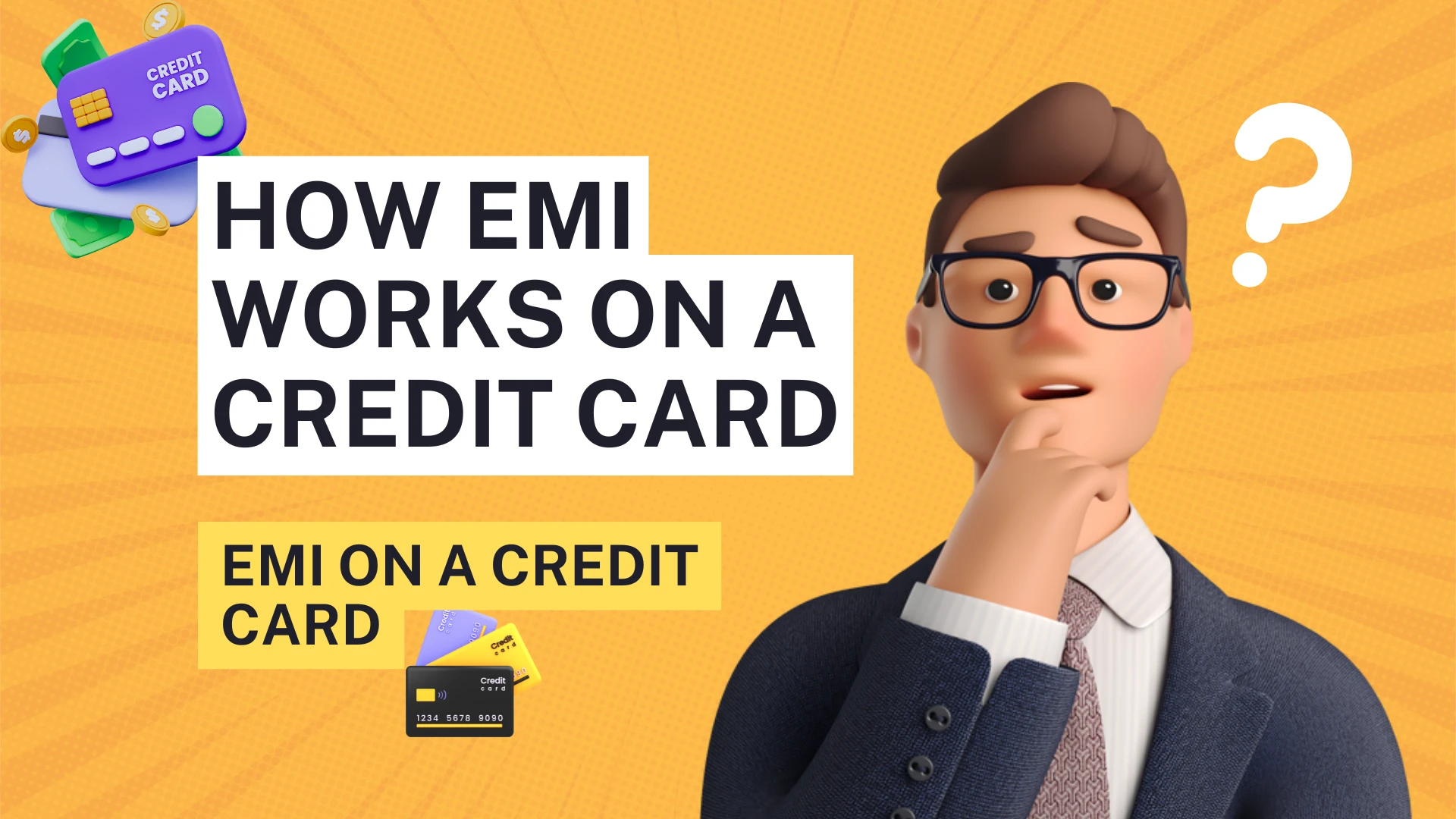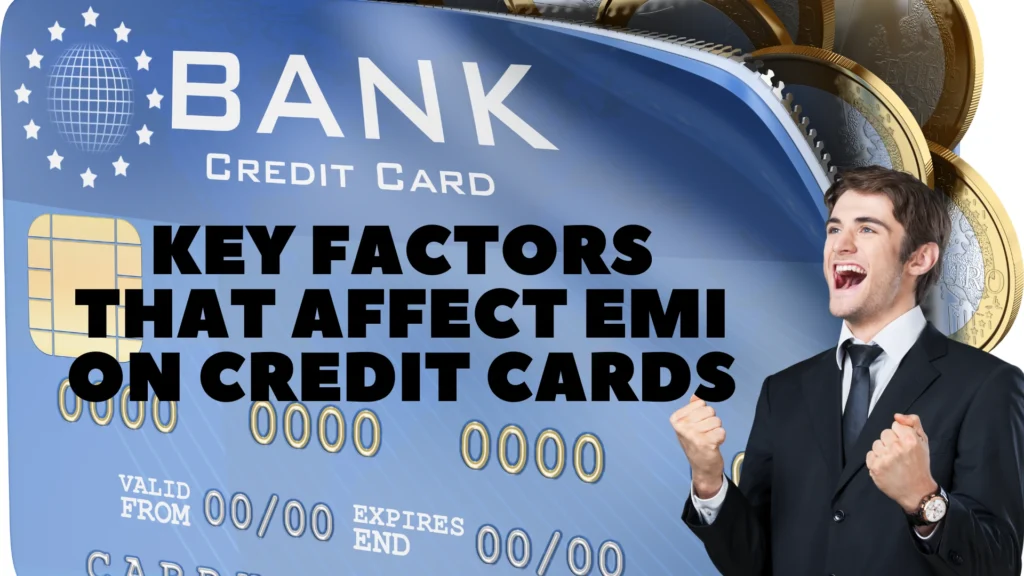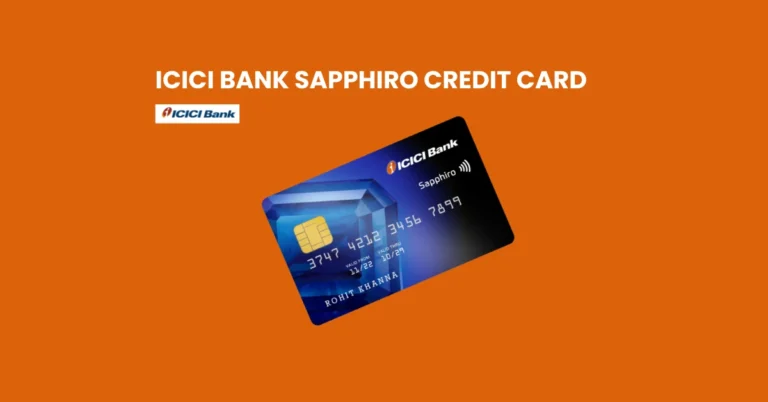How EMI Works on a Credit Card

A credit card has become an essential tool in dealing with daily expenses and emergencies. One important aspect to understand is how EMI works on a credit card purchase. That is one of the most attractive features for credit cards: the breaking down of huge purchases into the Equated Monthly Instalments, enabling one to divide repayment into manageable instalments. One can divide huge purchases into smaller amounts without burdening oneself financially by paying the huge amount at once.
Whether you are buying an expensive product that goes above your budget or you have a sudden expense, the working of EMI on your credit card can make your financial life much smoother. Hence, in this article, we shall discuss how EMI works on A Credit Card transaction, what EMI on a credit card means, and the key factors to consider before opting for it.
What is EMI on a Credit Card?
EMI on credit cards allows the user to spread the high-value purchases made on the credit card into smaller amounts that will be paid in instalments over a particular period. This implies that instead of having to pay the full amount at the time of when the credit card bill arises, you can pay this amount over time. This helps to diversify the cost in a way that makes it easier and within reach without over-straining users’ monthly budget as they pay their debt.
Take an example: you purchase something, say, worth Rs. 1 lakh, but your income is only up to Rs. 60,000 a month. You can then choose an EMI because it can be repaid in instalments. It may then become spread into five equal monthly repayments of Rs. 20,000 so that it becomes easier to pay. This is a simple example that demonstrates how EMI works on a Credit Card transaction in real-life scenarios.
Understanding how EMI works on credit card purchases helps you make smarter decisions when using your credit limit for large expenses. To better understand how EMI works, you can read about the detailed process in this article on What is Credit Card EMI?
How Does EMI Work on a Credit Card?
You can convert to EMI at the point of sale or through your bank or credit card provider’s online portal while purchasing with your credit card. If you’re wondering how EMI works on a credit card purchase, generally, it follows this process:
- Purchase a High-Value Item: Buy a product or service with your credit card that is greater than your monthly budget.
- Choose the EMI Option: You can ask your bank to convert the amount into EMIS at the time of buying or after a purchase. It is done through the mobile application of your bank, online banking, and in some cases, at the point of sale also.
- Select Tenure and Down Payment (Optional): Most of the banks will allow the customer to choose tenure, wherein one can choose repayment tenure that ranges from 6 months to 2 years, as per the policies of the banks. Some banks would also require a down payment.
- Monthly Payments: If you pay through EMI, then the total amount minus the down payment is divided into monthly instalments. These instalments with interest charges corresponding to the month are added to your credit card statement every month.
- Interest Charges: Depending upon the bank and the EMI scheme, an interest rate may be levied, which would be serviced throughout the tenure of repayment. The interest charged usually depends on the repayment period, down payment, and the policies of the respective banks.
How is EMI Calculated on Credit Cards?
The EMI you are supposed to pay every month is calculated basis of the following factors:
- Principal Amount: This is the principal amount to be paid back.
- Interest Rate: Interest rate charged by the bank to convert money into EMI. Every bank will charge interest differently, and it also depends on the tenure.
- Repayment Tenure: It is the term by which the borrower pays the amount of EMI to the bank. The lower would be the payable interest in the whole term, but in this case, the short term of repayment will increase your EMI amount.
Credit card EMI can also be estimated using a credit card EMI calculator provided by banks or money apps that offer such estimates for the amount of loan you will repay. This will give you an idea of the kind of interest you are going to pay on the purchase from your credit card.
Steps to Convert Credit Card Purchases into EMI
To fully understand how EMI works on A Credit Card purchase, it’s helpful to know the step-by-step process to convert a transaction into EMI.
- At the Point of Purchase: Merchants often give you this option of converting the transaction into EMI at the checkout while making a high-value purchase. That means you can choose your tenure and agree to the terms and conditions right then.
- Through the Bank’s Portal or App: Many banks allow you to convert credit card transactions into EMI post-purchase by accessing their online banking portal or mobile application. There would be an option to select the specific transaction, select tenure, and confirm the transaction for conversion.
- Contact Customer Service: In some instances, the request has to be made through the customer service helpline of your bank.

Key Factors that Affect EMI on Credit Cards
Among the most determining factors for how EMI works on A Credit Card usage, the following few are considered the key ones. These variables can significantly impact how EMI works on A Credit Card payment, influencing your monthly outflow and total interest.
1. Interest Rate
A large number of banks normally impose some rate of interest in converting a purchase into EMI. The interest rates vary somewhat differently among banks and may depend on the tenure, quantum, and the nature of customer relationship. It has been observed that generally, smaller repaying periods occur at lesser rates of interest, but longer tenures may attract higher interest rates.
2. Repayment Tenure
You are offered the flexibility to choose the repayment tenure for your EMIs, generally between 6 months and 2 years. Obviously you will understand that the tenure selected gives rise to a variation in the EMI payable in a month as well as the total interest paid over the loan period. The smaller the tenures, the higher will be the total interest paid but the EMI payable will rise.
3. Processing Fees
In some banks, a processing fee is levied on the credit card payments while converting them into EMIs. It could either be in terms of a fixed amount or as a percentage amount of the transaction. In seasons of festive joy, most of the banks have also devised promotions where the processing fees are waived off while getting converted the purchase into EMIs.
4. Foreclosure and Prepayment Options
Some banks let you foreclose (close the loan early) or prepay the balance EMI amount ahead of the tenor expiration. In this regard, though, banks might levy a small foreclosure or prepayment fee for the service, though charges vary from one bank to another. It is advisable to prepay if possible for savings on interest charges.
5. Reducing Balance Method
Almost all banks charge interest on credit card EMIs based on the reducing balance method. This means that interest is charged only and only on the outstanding amount after every instalment is paid. This implies that due to the reduction of outstanding balance every month, a cardholder suffers from less interest, which becomes helpful.
Benefits of Using EMI on Credit Cards
Use of EMI on credit cards provides several benefits as mentioned below:
- Affordability: EMI breaks up high-value purchases into smaller and more manageable payments. So, you can afford products at considerable amounts without imposing a burden on your finances.
- Convenience: You do not need to remember that amount for EMI as it becomes a part of the monthly credit card bill, and a reminder always comes in handy.
- No Need for Separate Loans: You would not have to approach the Bank for a separate personal loan to finance such purchases existing credit card makes it pointless.
- Flexible Tenure Options: Users have a wide range of tenure options- from a few months to years, depending on their convenience of paying.
- Boost Credit Score: If you pay the EMIs in the credit card in time, then it can boost your credit score, if you are paying other credit card expenses correctly.
Drawbacks of Using EMI on Credit Cards
Despite the benefits, there are a few downsides to consider. Knowing how EMI works on a credit card limits and fees can help you avoid hidden charges and stay financially prepared.
- Interest Charges: EMIS have with them interest charges that increase the total cost of any purchase.
- Credit Limit Reduction: Once you convert a purchase into EMI, your available credit limit comes down by the outstanding principal amount.
- Eligibility Criteria: Not all credit cards offer the EMI facility. Even if they do, the cardholder’s eligibility will come down to several factors, including credit history and repayment ability.
Read More:
Conclusion
Understanding how EMI works on a credit card payments can offer great financial flexibility, enabling users to make big purchases without straining their monthly budgets. In short, EMIs allow all users to have an opportunity to own products or services they might not otherwise be able to afford by breaking down the transaction of substantial values into more manageable offerings.
By learning how EMI works on A Credit Card platform across different banks, you gain better control over your repayment strategy. However, it should be balanced with other disadvantages such as interest charges and credit limits. Determine your eligibility for an EMI option on a credit card before availing it and then decide the tenure of repayment according to your financial condition. You can also make informed decisions about the amount you wish to spend or repay in comfort while availing a credit card by using tools like a credit card EMI calculator.






